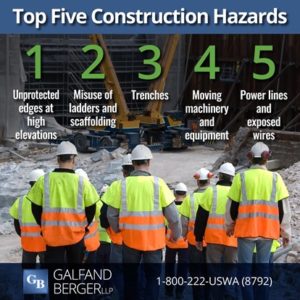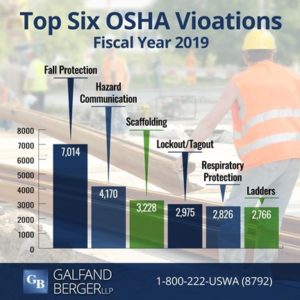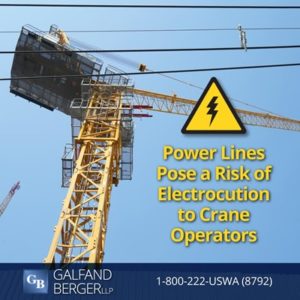New Jersey Construction Accident Lawyers
Each year, more than 5,000 workers die on the job in the United States, according to the Occupational Safety and Health Administration (OSHA). One in five worker fatalities are due to construction accidents. Greater awareness of construction site hazards and preventative safety measures can reduce the risk of accidents.
In New Jersey, Workers’ Compensation provides for medical treatment and wage replacement to employees who suffer job-related injuries or illnesses. Death benefits may also be available to dependents of workers who die as a result of work-related injuries or illness. When a third party other than the employer is legally responsible for the accident, the injured worker may be able to file a third-party claim to pursue damages. Third parties may include manufacturers of defective equipment or contractors whose negligence contributed to the accident. Injured workers can obtain legal advice regarding potential third-party claims from a qualified New Jersey construction accident lawyer.
 What Should Workers Know About Construction Site Hazards?
What Should Workers Know About Construction Site Hazards?
Construction site hazards can materialize without warning. The job site itself is often in a constant state of flux, as the acts of demolition and rebuilding continually alter workers’ surroundings. Attending safety meetings is one way that workers may be able to obtain information about new construction site hazards.
Another important fact is that construction site hazards can cause a wide variety of accidents, including the following:
- Falls, including slip and falls
- Struck-by object accidents
- Electrocutions
- Caught in/between accidents
- Explosions, fires, and gas leaks
- Machinery accidents
- Exposure to toxic substances
Injuries due to overexertion and repetitive stress are also common in the construction injury, although these injuries rarely result in fatalities. Weather hazards, including extreme heat and humidity, present risks to construction crews working long hours outside. Lack of rest breaks in the shade or failing to drink plenty of water can result in dehydration and heat stroke.
Certain types of tasks on the job site may produce repetitive stress injuries in the back, wrists, or joints. Common back injuries due to overexertion and repetitive stress account for more days away from work than any other injury. To help prevent lifting injuries, employers can use lifting equations provided by the National Institute for Occupational Safety and Health (NIOSH).
Important Facts About Highway Collisions
Highway collisions are the leading cause of private sector worker fatalities in the construction industry. Across all industries, transportation accidents account for nearly 40 percent of all fatal work injuries, according to the Bureau of Labor Statistics. Getting hit by a vehicle is all too common on highway construction sites. Tragically, these accidents are primarily due to driver error, such as speeding or distracted driving, and are therefore, entirely preventable. In many areas, the fines for speeding violations are doubled in construction zones to convey to motorists the dangers they pose to highway construction workers.
What Fall Hazards Should Workers Look for at Construction Sites?
Construction workers often perform their jobs from high places, such as on scaffolding, rooftops, or ladders. Falling from a high elevation is the most common type of fatal construction accident, causing more than one-third of all construction-related fatalities. Workers should look for the following fall hazards whenever they are at a construction site:
- Open elevator shafts and skylights
- Unprotected sides, including unguarded ledges
- Floor holes
- Protruding steel bars
- Slippery surfaces and tripping hazards on roofs
- Improperly constructed scaffolding
- Ladder misuse
Scaffolding accidents in particular can be dangerous. Excessive loads can cause scaffolds to collapse or tip over. Falls from scaffolding may also be caused by lack of proper fall protection. Misuse of ladders can occur when workers attempt to climb while holding objects. Using a ladder that is too short or too narrow can result in an accident. Placing the ladder at the wrong angle or on uneven ground can be particularly risky. Slip and fall accidents are also common at construction sites. Workers can easily suffer sprains and broken bones simply by tripping over tools or debris on the ground.
How Can Workers Avoid Falling at a Construction Site?
Workers can avoid falling at a construction site by following these guidelines:
- Never attempt to reach out or lean while on a ladder.
- Never stand on the top rung of a ladder.
- Always use a ladder that is wide and tall enough for the job.
- Ensure scaffolding is properly constructed and inspected before use.
- Make sure guardrails are in place on roofs and around stair openings or elevator shafts.
- Clear roofs and other elevated work areas from debris and tools.
- Wear a hard hat in the vicinity of scaffolding.
- Never climb on a scaffold’s cross-bracing.
- Use a personal fall arrest system (PFAS) when available.
A PFAS can stop the motion of a falling worker and includes a body harness that evenly distributes the force of a fall, as well as a connecting device that attaches the harness to a secure anchor. Employers can help prevent injuries by adhering to OSHA standards. By far, OSHA issues more fall protection violations than another other category. Scaffolding violations account for the third-most common OSHA violation.

Requirements for scaffolding include the following:
- Supervisors must be informed whenever scaffolds are constructed or moved.
- Scaffolds must include OSHA-compliant toe board, guardrail, and midrail systems.
- Each scaffold must be able to support four times the maximum intended load.
- Scaffolds must be inspected before every shift.
- Scaffolds must be kept free of ice and snow.
Workers should also be on the lookout for scaffolds that look worn out or defective and then alert a supervisor if something looks unsafe. Likewise, when using a ladder, workers should ask for help if they are unsure about its angle or placement. It is easy to grow complacent about ladder and scaffolding safety after working in construction for years. However, extra caution can make the difference between going home at night or ending up in a hospital.
Struck-By Object Hazards
Approximately 10 percent of construction site injuries are caused by falling objects or getting hit by construction vehicles. Falling objects can cause traumatic brain injury (TBI), as well as neck and back injuries. When an object, such as a hammer, brick, or piece of masonry, drops from a tall height, it quickly picks up speed. Even small objects can be deadly if dropped from a high elevation. Tools and pieces of scaffolding can easily fall from high areas of a construction site if precautions are not followed. Cranes present additional hazards. In April 2019, a New York City construction worker was killed by a falling crane counterweight.
How Can Workers Prevent Struck-By Accidents?
There are several steps that construction workers can take to prevent struck-by accidents, including the following:
- When working at heights, use lanyards to secure hammers and other tools.
- Stack working materials carefully and away from open edges.
- Ensure that crane loads are properly rigged and secured before hoisting.
- Do not lift heavy loads over the head of another worker.
If it is impossible to properly secure or guard objects at heights, barricades should be used to block off areas below where objects may fall.
Electrocution Hazards
Nearly 10 percent of all fatalities in the construction industry are due to electrocution, when workers come into direct contact with high voltage wires. When it is not fatal, electrocution can result in amputated limbs and disfigurement. Electrocution hazards include down power lines, as well as unfinished electrical systems and exposed wires, which are not uncommon on construction sites. Lack of ground fault and improper use of electrical wires and components also creates hazards. Although electricians working on a construction site routinely face hazards of working with high voltage, roofers, crane operators, and other non-electricians risk coming in contact with overhead or underground power lines.
How Do Cranes Increase the Risk of Electrocutions?
A study of construction accidents published by the Centers for Disease Control and Prevention (CDC) found that more than 30 percent of fatalities related to the use of cranes were caused by electrocution. Carefully adhering to safety protocols is particularly important when operating a crane that is moving heavy loads at high elevations.

Inspecting cranes before each shift can help prevent accidents. Most importantly, operators must be thoroughly trained on all aspects of rigging and operation. Loads should never exceed the crane’s maximum lifting capacity.
Preventing Electrocutions
According to the CDC, construction workers are nearly four times more likely to be electrocuted than workers from all other industries combined. Electrocution hazards are not always obvious on job sites. The most effective way to prevent electrocutions is for supervisors to identify live sources of electricity at regular worksite safety meetings. Special consideration should be given to construction workers who speak limited English. Warning signs should use icons in addition to words to get the message across. Steps that workers can take to avoid getting electrocuted include the following:
- Watch for temporary power sources that may appear at any time on the job site.
- Scaffolds should never be placed closer than 10 feet from power lines.
- Crane operations should maintain a distance of at least 20 feet from power lines.
- Follow lock-out/tag-out procedures so that machines are not activated unintentionally.
- Inspect power cords and extension cords before use.
Supervisors should clearly mark the locations of power lines overhead and underground. OSHA violations regarding electrical wiring and general electrical guidelines are fairly common. Simply following OSHA guidelines can help prevent electrocutions.
What are the Primary Hazards Leading to Caught In/Between Accidents?
Caught in/between accidents occur when workers are crushed or compressed between two or more objects. Injuries that may result include asphyxiation, broken ribs, and other broken bones and bruises. According to OSHA, the three primary hazards leading to caught in/between accidents include the following:
- Trench cave-ins
- Machinery components or vehicles that can trap and compress a worker, such as the back of a garbage truck or a forklift
- Machinery that can grab or pull a worker
Caught in/between accidents may be caused by collapsing structures as well.
Trenches are common features at construction sites. When trenches are dug without protective systems, the ground and surrounding areas may become unstable and collapse on workers, leaving them unable to get out on their own.
How Can Workers Avoid Caught In/Between Accidents?
Workers can avoid caught in/between accidents involving trenches by constructing proper protective systems for trenches deeper than five feet. Trenches should be inspected regularly. Changes in the weather or placing heavy machinery near trench walls can cause soil to shift.
Forklift drivers can prevent caught in/between accidents involving their vehicles by driving only on marked paths known to employees. Forklift drivers should be trained to inspect, as well as operate and maintain their vehicles. With regular safety training, many caught in/between accidents can be avoided.
Installing machinery guards can help prevent caught in/between accidents in which workers are pulled into machine components. OSHA provides standards for maintaining proper machine guards. Unfortunately, machine guard violations are among the top 10 most common citations issued by OSHA.
How Can Workers Pay for the Cost of Injuries?
According to the Bureau of Labor Statistics, more than one-fourth of all construction workers have been injured on the job at some point in their careers. Employees who are hurt in the workplace are entitled to receive Workers’ Compensation benefits to cover the cost of their injury. Payment of benefits is the employer’s responsibility. The procedures involved in obtaining Workers’ Compensation can be complex. It is often in the best interest of an injured construction worker to hire a Workers’ Compensation lawyer to assist with this process.
If a worker is injured in a construction accident, they may also have the right to file a third-party claim in addition to obtaining Workers’ Compensation benefits. Third parties may include general contractors, subcontractors, manufacturers of defective or unsafe construction equipment, or entities other than the employer whose misconduct or negligence may have contributed to the accident.
When general contractors work with subcontractors and equipment and material suppliers, each subcontract typically spells out specific safety responsibilities and liabilities for any accidents. However, the general contractor is typically responsible for overall safety on a worksite. A qualified construction accident lawyer can advise injured workers regarding their options for covering costs arising from a construction accident.
New Jersey Construction Accident Lawyers at Galfand Berger LLP Advocate for Injured Construction Workers
If you were injured in a construction accident, it is in your best interest to contact the New Jersey construction accident lawyers at Galfand Berger LLP. Our qualified attorneys can answer any questions or concerns you may have. For a free consultation, call us today at 800-222-8792 or complete our online contact form. From our offices in Philadelphia, Bethlehem, Lancaster, and Reading, Pennsylvania, we proudly help injured workers throughout New Jersey and Pennsylvania, including Allentown and Harrisburg.
 Google Screened
Google Screened
